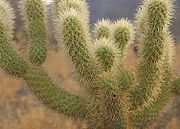Cylindropuntia bigelovii
| Cylindropuntia bigelovii Teddy-bear Cholla | |
|---|---|
 | |
| Scientific classification | |
| Kingdom: | Plantae |
| (unranked): | Angiosperms |
| (unranked): | Eudicots |
| (unranked): | Core eudicots |
| Order: | Caryophyllales |
| Family: | Cactaceae |
| Genus: | Cylindropuntia |
| Species: | C. bigelovii |
| Binomial name | |
| Cylindropuntia bigelovii (Engelm.) F.M.Knuth | |
| Synonyms | |
|
Opuntia bigelovii | |
Cylindropuntia bigelovii, the teddy-bear cholla, is a cholla cactus species native to California, Arizona, and Nevada (USA) and Northwestern Mexico.
Description
Cylindropuntia bigelovii has a soft appearance due to its solid mass of very formidable spines that completely cover the stems, leading to its sardonic nickname of "teddy bear".
The teddy-bear cholla is an erect plant, standing 1 to 5 ft (0.30 to 1.52 m) tall with a distinct trunk. The branches are at the top of the trunk and are nearly horizontal. Lower branches typically fall off, and the trunk darkens with age. The silvery-white spines, which are actually a form of leaf, almost completely obscure the stem with a fuzzy-looking, but impenetrable, defense. The spines are 1 in (2.5 cm) long and are covered with a detachable, paper-like sheath.
The yellow-green flowers of this cactus emerge at the tips of the stems in May and June, and the fruits that follow usually have no viable seed. Flowers are usually 1.375 in (3.49 cm) in length. The fruit is 0.75 in (1.9 cm) in diameter, tuberculate, and may or may not have spines. These cacti produce few seeds, as the plant usually reproduces from dropped stems. These stems are often carried for some distance by sticking to the hair of animals. Often small "stands" of these chollas form that are largely clones of one individual.
Like its cousin the jumping cholla, the stems of this cactus detach easily and the ground around a mature plant is often littered with scattered cholla balls and small plants starting where these balls have rooted. When a piece of this cholla sticks to an unsuspecting person, a good method to remove the cactus is with a hair comb. The spines are barbed, and hold on tightly. Desert pack rats such as the Desert Woodrat gather these balls around their burrows, creating a defense against predators.
The teddy-bear cholla is extremely combustible.
Distribution
Cylindropuntia bigelovii, the Teddy-bear cholla, grow in desert regions at elevations from 100 to 300 ft (30 to 91 m) in the "Low Desert" or Colorado Desert of Southern California, and other Sonoran Desert regions of the Southwestern United States and northwestern México.
In the Lower Colorado River Valley, the most dense Cylindropuntia bigelovii stands are at higher elevations, in the rockiest sites. There are fewer Sonoran Desert or Colorado Desert plant association species, however two are common though reduced in size: Ocotillo (Fouquieria splendens) and Saguaro (Carnegiea gigantea).
Gallery
-

A stand of Cylindropuntia bigelovii
-

Close up of teddy-bear cholla
-
Flowering Cylindropuntia bigelovii
-

Blooming Cylindropuntia bigelovii with bird nest, in Anza Borrego Desert State Park
-
Skeleton of a dead Teddy Bear Cholla--commonly known as "Ventilated Wood". Taken on the south side of Donnell Hill, Twentynine Palms, CA on 28July2014
References
- The Living Desert
- Teddy-bear Cholla - University of Arizona Pima County Cooperative Extension entry
| Wikimedia Commons has media related to Cylindropuntia bigelovii. |
External links
| Wikispecies has information related to: Cylindropuntia bigelovii |

